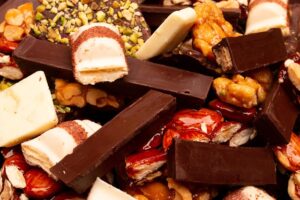Unleashing the Science: Perfecting Kids’ Birthday Cookies
Kids Birthday Cookies aren't just about mixing ingredients; they're a blend of science and…….

Kids Birthday Cookies aren't just about mixing ingredients; they're a blend of science and art. Balancing flour, sugar, butter, eggs, and flavorings, along with understanding roles like gluten formation, fat's impact on flavor, and sugar's dual function in browning and moisture, is key to creating light, crispy cookies. Proper handling techniques—gentle mixing, chilling, and monitoring oven temperature—ensure perfect results. The magic lies in the interplay of ingredients and chemical reactions, particularly leavening agents that create a light, airy texture. Baking science focuses on balancing temperature and mixing techniques for optimal texture and consistency.
Unleash your inner baker and explore the captivating science behind creating the perfect Kids’ Birthday Cookies. From the initial blend of ingredients to the final frosted delight, every step involves intricate chemical reactions. Learn how leavening agents, temperature control, and mixing techniques transform simple dough into crispy or chewy treats that delight young palates. Discover ingredient secrets for crafting flavors kids love and master decorating tricks to make your birthday cookies truly spectacular.
- Understanding the Basic Science Behind Cookie Dough
- – Chemical reactions in baking: leavening agents and their role
- – The importance of temperature and mixing techniques
Understanding the Basic Science Behind Cookie Dough

Cookie dough, a simple mixture of flour, sugar, butter, eggs, and flavorings, is more than meets the eye for young bakers. Understanding the science behind it can turn kids’ birthday cookies from mundane treats into delightful culinary creations. The key lies in the balance of ingredients: too much liquid or fat can lead to runny dough, while too little will result in dry, brittle cookies. Proteins in flour form the structure of the cookie, with gluten forming a network that traps air bubbles created during mixing and baking, contributing to the light, crispy texture we love. Fats, like butter, create flavor and tenderness, while sugar plays a dual role: caramelizing at high temperatures for golden-brown edges and adding moisture to prevent cracking.
Proper handling of dough is crucial, especially when kids are involved. Overmixing can develop gluten excessively, leading to tough cookies. Instead, gentle mixing ensures the dough comes together without overactivating the gluten. Chilling dough before baking allows for even texture and makes it easier to handle, preventing accidental sticky fingers. For ideal Kids Birthday Cookies, allow enough time for chilling, and be mindful of oven temperature—too hot can cause rapid browning while not baking thoroughly in the center.
– Chemical reactions in baking: leavening agents and their role

The magic of baking cookies lies in a fascinating interplay of ingredients and chemical reactions. One key element is leavening agents, such as baking powder or soda, which are essential for creating that light, airy texture we all love. These agents work by releasing gases during the baking process, causing the dough to rise and expand, much like a silent explosion of flavor and airiness. In the context of Kids Birthday Cookies, understanding this chemical reaction can make decorating and customizing them more engaging and educational for young bakers.
Imagine explaining to curious kids that adding baking soda to their cookie dough isn’t just about making the cookies fluffy—it’s a scientific reaction that transforms simple ingredients into a delightful treat. This knowledge can foster a deeper appreciation for both cooking and science, encouraging young minds to experiment and explore the wonders of flavor and texture in the kitchen.
– The importance of temperature and mixing techniques

The science behind baking perfect cookies begins with understanding temperature and mixing techniques. Getting the temperature just right is crucial, as it affects the structure and texture of your treats. For instance, too much heat can cause the butter to melt too quickly, resulting in flat, crisp cookies that spread beyond their desired shape. Conversely, insufficient heat might leave your dough undercooked, yielding chewy or tough cookies.
Mixing techniques also play a significant role in achieving the ideal Kids Birthday Cookie. Overmixing can incorporate too much air into the dough, leading to a fragile structure that may result in cracks upon cooling. On the other hand, undermixing could leave behind dry patches or unevenly incorporated ingredients, impacting both texture and flavor. The key is to mix until just combined, ensuring a smooth yet not overly aerated dough for consistently delightful cookies.







